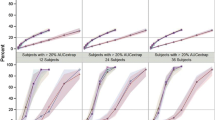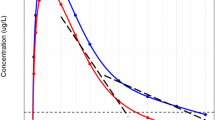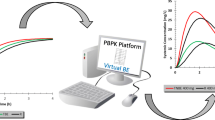Abstract
Purpose. The use of truncated areas under the curve (AUCs) could be a significant advantage for bioequivalence studies of drugs with long half-lives. The purpose of this study was to evaluate the performance of truncated AUCs as measures of relative extent of bioavailability using a large database of experimental data and Monte Carlo simulations.
Methods. The experimental data consisted of 123 single-dose, 2-treatment, crossover studies with at least 18 subjects/study. Monte Carlo techniques were also used to simulate studies that reflected a wide variety of experimental conditions. AUCs were calculated over different time intervals and the standard two one-sided t tests procedure was used to assess bioequivalence.
Results. The experimental data showed that conclusions concerning bioequivalence were identical between AUCs truncated at four times the time of peak concentration (Tmax) and AUCs extrapolated to infinity (AUCinf) in 120/123 or 97.6% of studies. There was little change in the intra-subject CVs for AUCs truncated at 3*Tmax or later. The results of Monte Carlo simulations were generally consistent with the experimental data and showed that AUCs truncated at 72 hours (AUC0−72) performed well compared to AUCinf as measures of bioequivalence for drugs with long half-lives.
Conclusions. Based on both the experimental and simulated data, AUCs truncated after the absorption phase perform well as measures of relative extent of bioavailability. Truncated AUCs offer a particular advantage for drugs with long half-lives and these results indicate that it would be reasonable to limit the sample collection period to 72 hours in bioequivalence studies of oral formulations.
Similar content being viewed by others
REFERENCES
D. J. Schuirmann. A comparison of the two one-sided tests procedure and the power approach for assessing the equivalence of average bioavailability. J. Pharmacokinet. Biopharm. 15:657-680 (1987).
G. van Belle and D. C. Martin. Sample size as a function of coefficient of variation and ratio of means. Am Stat 47:165-167 (1993).
R. L. Lalonde, J. Lavigne, D. Potvin, E. K. Kimanani, and J. Gaudreault. Variability of pharmacokinetic (PK) parameters. Pharm. Res. 13:S-451 (1996).
F. Y. Bois, T. N. Tozer, W. W. Hauck, M. L. Chen, R. Patnaik, and R. L. Williams. Bioequivalence: performance of several measures of extent of absorption. Pharm. Res. 11:715-722 (1994).
L. Endrenyi and L. Tothfalusi. Truncated AUC evaluates effectively the bioequivalence of drugs with long half-lives. Int. J. Clin. Pharmacol. Ther. 35:142-150 (1997).
E. G. Lovering, I. J. McGilveray, I. McMillan, and W. Tostowaryk. Comparative bioavailabilities from truncated blood level curves. J. Pharm. Sci. 64:1521-1524 (1975).
K. K. Midha, J. W. Hubbard, M. Rawson, and L. Gavalas. The application of partial areas in assessment of rate and extent of absorption in bioequivalence studies of conventional release products: experimental evidence. Eur. J. Pharm. Sci. 2:351-363 (1994).
K. K. Midha, J. W. Hubbard, and M. J. Rawson. Retrospective evaluation of relative extent of absorption by use of partial areas under the plasma concentration versus time curves in bioequivalence studies on conventional release products. Eur. J. Pharm. Sci. 4:381-384 (1996).
M. N. Martinez and A. J. Jackson. Suitability of various noninfinity area under the plasma concentration-time curve (AUC) estimates for use in bioequivalence determinations: relationship to AUC from zero to time infinity (AUC0__inf). Pharm. Res. 8:512-517 (1991).
K. K. Midha, J. W. Hubbard, M. J. Rawson, G. McKay and R. Schwede. The roles of stereochemistry and partial areas in a parallel design study to assess the bioequivalence of two formulations of hydroxychloroquine: A drug with a very long half-life. Eur. J. Pharm. Sci. 4:283-292 (1996).
Author information
Authors and Affiliations
Corresponding author
Rights and permissions
About this article
Cite this article
Gaudreault, J., Potvin, D., Lavigne, J. et al. Truncated Area Under the Curve as a Measure of Relative Extent of Bioavailability: Evaluation Using Experimental Data and Monte Carlo Simulations. Pharm Res 15, 1621–1629 (1998). https://doi.org/10.1023/A:1011971620661
Issue Date:
DOI: https://doi.org/10.1023/A:1011971620661




